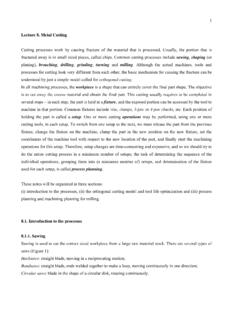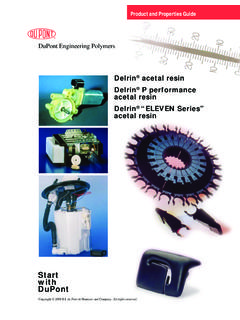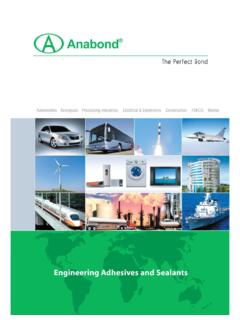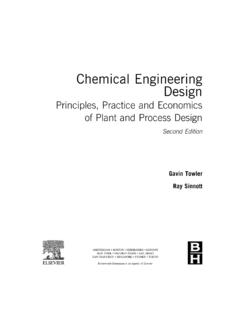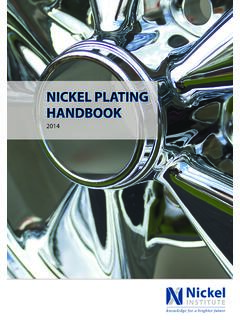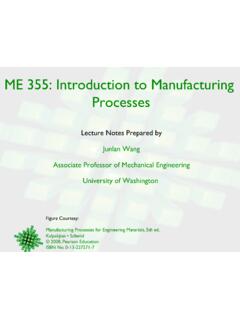Transcription of Lecture 1. Material Properties 1. Background
1 1 Lecture 1. Material Properties 1. Background Manufacturing is the process of converting some Material into a part or product. It is the most fundamental activity in any civilization. Everything around you, every item you use, is manufactured. Each object you use is made up of components, each of which utilized very specialized equipment to make it. Our goal in this course is (a) when we see things around us, we should be able to answer, in most cases, how was it made ; (b) we will gain the ability to detect problems with products, and suggest alternate materials/processes that could improve them; (c) we should be able to build a model of a process, and perform analysis that will indicate the optimum conditions for the use of the process under some specified criteria; (d) we should gain some understanding of the economics of manufacturing products.
2 Example 1. A bottle of Watson s water (~HK$6) Figure 1. A Plastic water bottle Four components (bottle, cap, label, water) - How are each of these manufactured? What does the equipment cost? Example 2. Stapler (~HK$ 45) Figure 2. A Stapler Approximately 15 components; - How do we select the best Material for each component? - How are each of these manufactured? 2 Now consider a car it has approximately 15000 parts; or a Boeing 747-400 plane, with over 6 million parts! Consider your PC; it probably has an Intel Pentium processor, which has millions of tiny electronic components, the feature size, the separation between the components is around 90 nanometers.
3 How can you manufacture such tiny components? In order to understand how things are made, we must first understand how they behave. This understanding is crucial in deciding whether they are good for a particular design, and also in deciding the best manufacturing process to use. 2. Materials There are an endless number of materials that are used in modern manufacturing. Here are some basic kinds: Ferrous metals (iron-alloys): carbon-, alloy-, stainless-, tool-and-die steels Non-ferrous metals: aluminum, magnesium, copper, nickel, titanium, superalloys, refractory metals, beryllium, zirconium, low-melting alloys, gold, silver, platinum.
4 Plastics: thermoplastics (acrylic, nylon, polyethylene, ABS,..), thermosets (epoxies, Polymides, Phenolics, ..), elastomers (rubbers, silicones, polyurethanes, ..) Ceramics, Glasses, Graphite, Diamond, Cubic Boron Nitride, .. Composites: reinforced plastics, metal matrix and ceramic matrix composites Nanomaterials, shape-memory alloys, superconductors, .. - Can you think of at least one example where each of the above is used? 3 3. Properties of materials We shall concern ourselves with three types of issues: (a) Mechanical Properties of materials (strength, toughness, hardness, ductility, elasticity, fatigue and creep). (b) Physical Properties (density, specific heat, melting and boiling point, thermal expansion and conductivity, electrical and magnetic Properties ) (c) chemical Properties (Oxidation, corrosion, flammability, toxicity, etc.)
5 Mechanical Properties Mechanical Properties are useful to estimate how parts will behave when they are subjected to mechanical loads (forces, moments etc.). In particular, we are interested to know when the part will fail ( break, or otherwise change shape/size to go out-of-specification), under different conditions. These include loading under: tension, compression, torsion, bending, repeated cyclic loading, constant loading over long time, impact, etc. We are interested in their hardness, and how these Properties change with temperature. We are sometimes interested in their conductivity (thermal, electrical) and magnetic Properties . Let s look at how these Properties are defined, and how they are tested.
6 Basics of Stress Analysis We briefly study the basics of solid mechanics, which are essential to understand when materials break (this is important in product design, where we usually do not want the Material to break; it is important in manufacturing, where most operations, cutting, are done by essentially breaking the Material ). Essentially, any load applied to a solid will induce stress throughout the solid. There are two types of stresses: shear and tensile/compressive, as shown in the figure below. Consider that some force(s) are applied to a solid such that it is experiencing stress but is in stable equilibrium. We consider an infinitesimal element inside the solid under such stresses.
7 4 TensionCompressionShearF1F2F3 x xy y z xz zx zy yx yzTensionCompressionShearF1F2F3 x xy y z xz zx zy yx yzF1F2F3 x xy y z xz zx zy yx yz Figure 3. Tensile, compressive and shear stresses; stresses in an infinitesimal element of a beam The question we need to answer is: under some given set of stresses as shown, will the Material fail? To simplify matters, let s look at the 2D situation (XY plane only). To answer our question, we first find the resultant stresses, and , along some arbitrary direction inclined at angle to the y-axis (see figure below). Since the element is at equilibrium, the resultant of all forces must balance. Also, by definition, stress = force/area.
8 From this, we get the following relation: x xy yx x y y yx xy y yx xy x x x xy yx x y y yx xy y yx xy x x Figure 4. Computing the principal stresses (2D case) 2sin2cos22xyyxyx+ ++= (1) 2cos2sin2xyxy+ = (2) Differentiating (1) and equating to zero, we get: 5 yxxy =22tan (3) Equation (3) gives two values of the angle , one at which the principal stress is maximum, and the other at which it is minimum.
9 The corresponding value of are called the principal stresses. The angle between the two principal stresses is always 90 . If you calculate the shear stress along the direction of the principal stress (called the principal directions), you will find that it is zero. Likewise, differentiating (2) and equating to zero, we can solve for the angles at which we get maximum/minimum shear stresses: xyyx 22tan = (4) And again, if you calculate the tensile/compressive stress corresponding to these angles, you will get: 2yx += (5) Which indicates that in the direction of the principal shear stress, the two normal stresses are equal (but not zero). Similar relations can be found for the general, 3D case, but are outside the scope of this course.
10 Our interest is limited to note the fact that under some loading conditions, we can compute the stresses in any region of the part (by considering a small element at that location), and then compute the corresponding principal stresses. If the principal stresses (normal or shear) are higher than the strength of the Material (we shall soon define strength), then the Material will fail. A detailed study of how to compute the stresses in non-uniform shaped parts is outside the scope of this course, but we shall look at some simple cases, which are important. Failure in Tension, Young s modulus and Tensile strength Consider a uniform bar of cross section area Ao and length Lo, that is held at both ends and pulled by a force, P.

